Abstract
OBJECTIVE: The objective of this study was to elucidate the significance and limitations of serum amylase levels in the diagnosis of blunt injury to the pancreas. SUMMARY BACKGROUND DATA: Several recently published reports of analyses of patients with blunt abdominal trauma have indicated that determination of the serum amylase level on admission seemed to be of little value in the diagnosis of acute injury to the pancreas. Few previous reports have described clearly the significance and the limitations of the serum amylase level in diagnosing injury to the pancreas. METHODS: Retrospective analysis of 73 patients with blunt injury to the pancreas during 16-year period from February 1980 to January 1996 was performed. The factors analyzed in the current study included age, gender, time elapsed from injury to admission, hypotension on admission, type of injury to the pancreas, intra-abdominal- and intracranial-associated injuries, and death. RESULTS: The serum amylase level was found to be abnormal in all patients admitted more than 3 hours after trauma. Various comparisons between patients with elevated (n = 61, 83.6%) and nonelevated (n = 12, 16.4%) serum amylase levels showed the statistical significance solely of the time elapsed from injury to admission (7 +/- 1.5 hours vs. 1.3 +/- 0.2 hour, p < 0.001). The major factor that influences the serum amylase level on admission appeared to be the time elapsed from injury to admission. Determination of the serum amylase level is not diagnostic within 3 hours or fewer after trauma, irrespective of the type of injury. CONCLUSIONS: To avoid failure in the detection of pancreatic injury, the authors advocate determination of serum amylase levels more than 3 hours after trauma.
Full text
PDF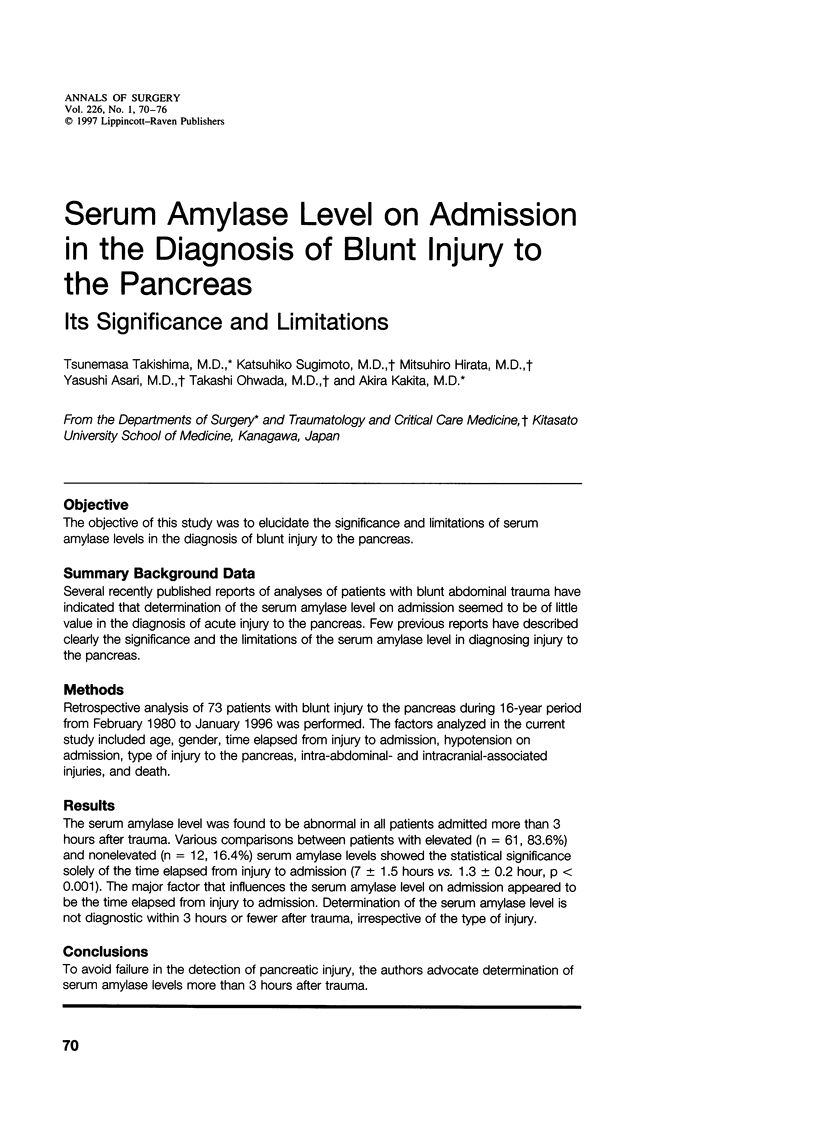

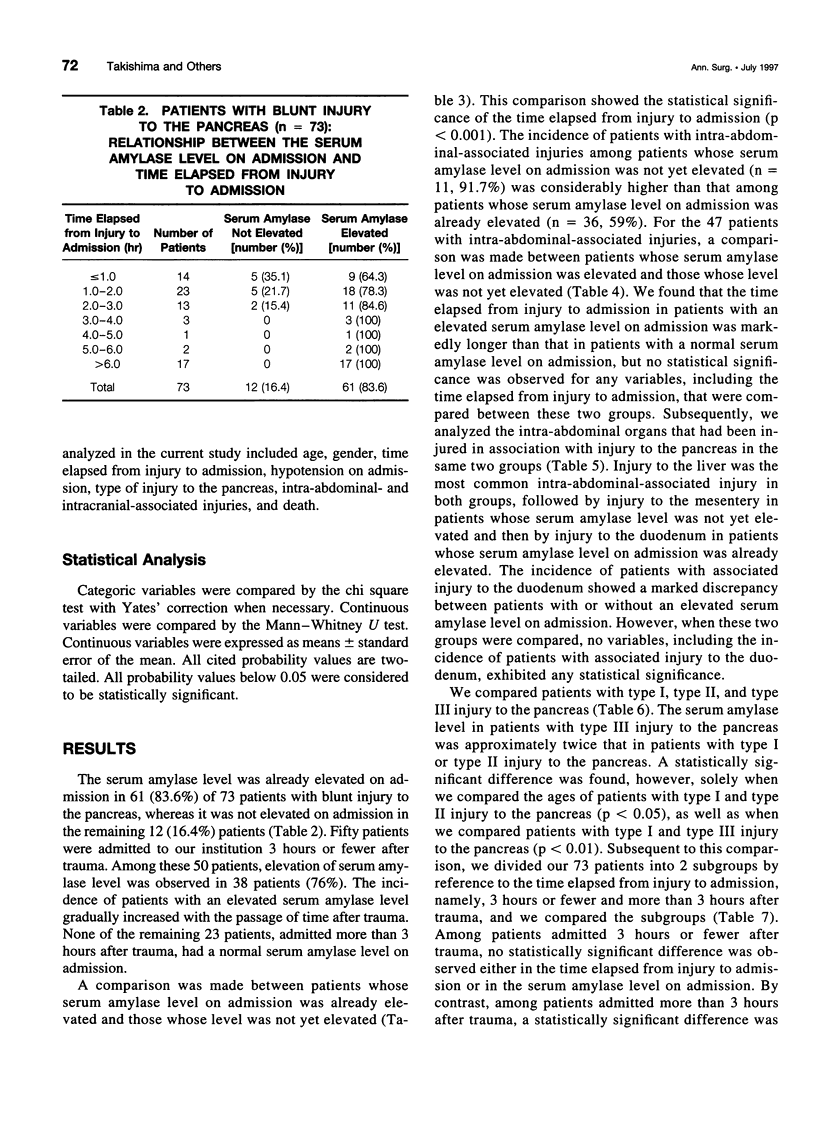

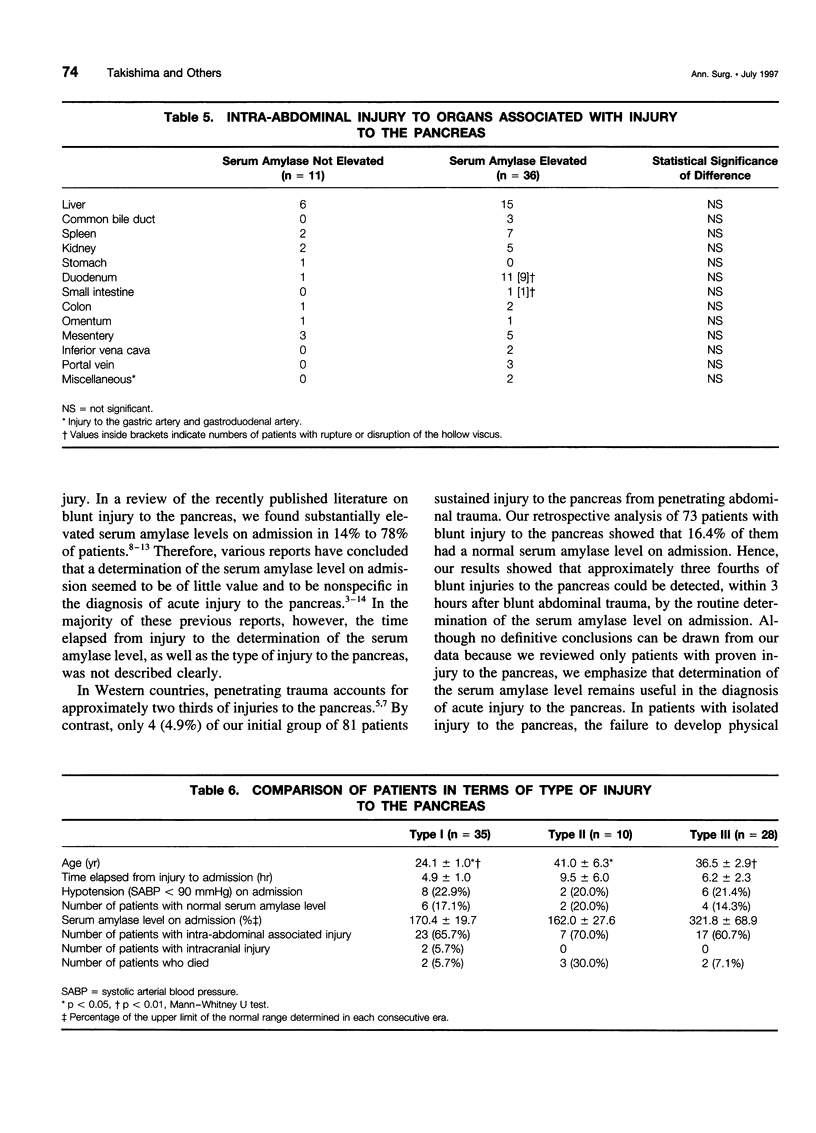
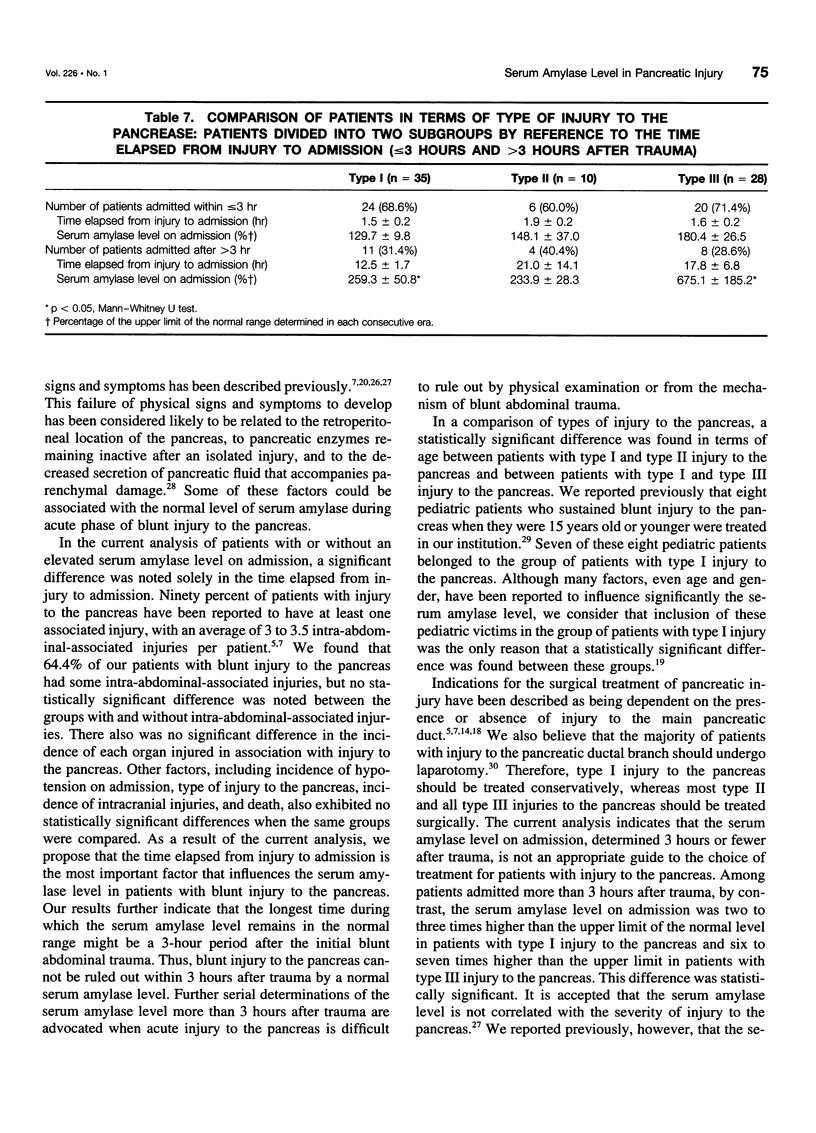
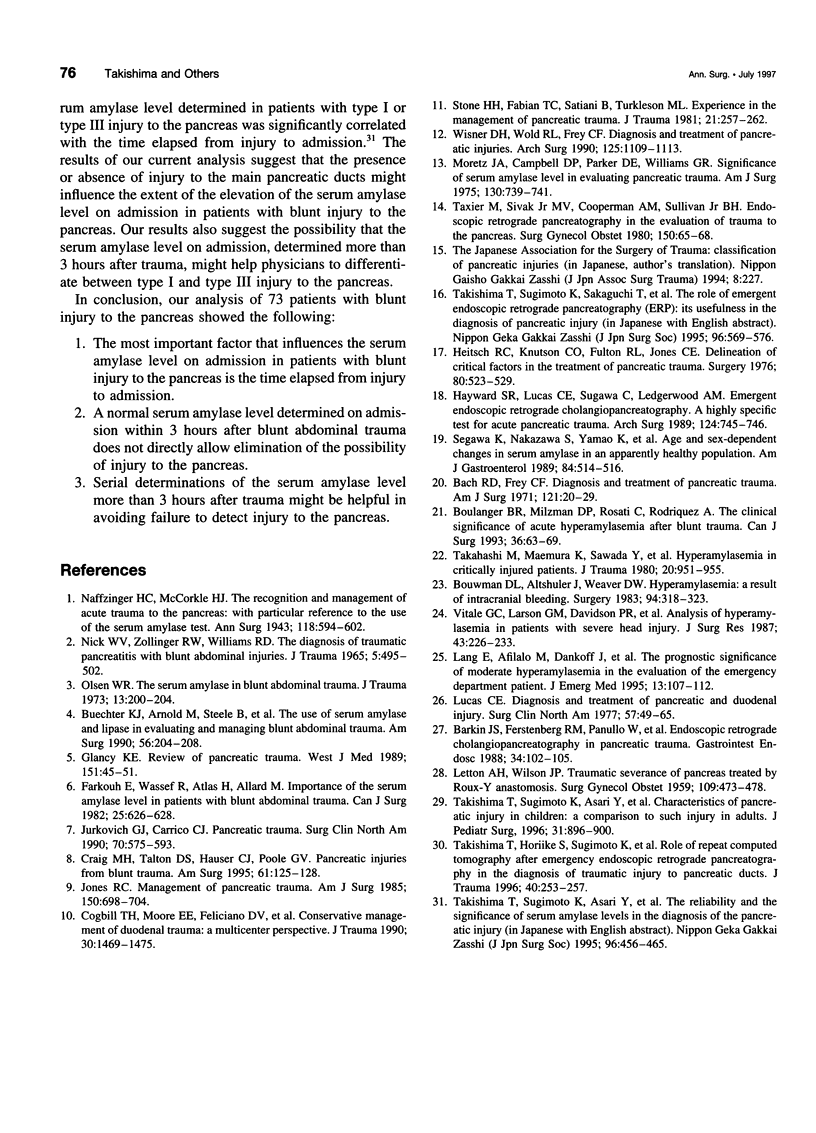
Selected References
These references are in PubMed. This may not be the complete list of references from this article.
- Bach R. D., Frey C. F. Diagnosis and treatment of pancreatic trauma. Am J Surg. 1971 Jan;121(1):20–29. doi: 10.1016/0002-9610(71)90073-0. [DOI] [PubMed] [Google Scholar]
- Barkin J. S., Ferstenberg R. M., Panullo W., Manten H. D., Davis R. C., Jr Endoscopic retrograde cholangiopancreatography in pancreatic trauma. Gastrointest Endosc. 1988 Mar-Apr;34(2):102–105. doi: 10.1016/s0016-5107(88)71272-9. [DOI] [PubMed] [Google Scholar]
- Boulanger B. R., Milzman D. P., Rosati C., Rodriguez A. The clinical significance of acute hyperamylasemia after blunt trauma. Can J Surg. 1993 Feb;36(1):63–69. [PubMed] [Google Scholar]
- Bouwman D. L., Altshuler J., Weaver D. W. Hyperamylasemia: a result of intracranial bleeding. Surgery. 1983 Aug;94(2):318–323. [PubMed] [Google Scholar]
- Buechter K. J., Arnold M., Steele B., Martin L., Byers P., Gomez G., Zeppa R., Augenstein J. The use of serum amylase and lipase in evaluating and managing blunt abdominal trauma. Am Surg. 1990 Apr;56(4):204–208. [PubMed] [Google Scholar]
- Cogbill T. H., Moore E. E., Feliciano D. V., Hoyt D. B., Jurkovich G. J., Morris J. A., Mucha P., Jr, Ross S. E., Strutt P. J., Moore F. A. Conservative management of duodenal trauma: a multicenter perspective. J Trauma. 1990 Dec;30(12):1469–1475. doi: 10.1097/00005373-199012000-00005. [DOI] [PubMed] [Google Scholar]
- Craig M. H., Talton D. S., Hauser C. J., Poole G. V. Pancreatic injuries from blunt trauma. Am Surg. 1995 Feb;61(2):125–128. [PubMed] [Google Scholar]
- Farkouh E., Wassef R., Atlas H., Allard M. Importance of the serum amylase level in patients with blunt abdominal trauma. Can J Surg. 1982 Nov;25(6):626–628. [PubMed] [Google Scholar]
- Glancy K. E. Review of pancreatic trauma. West J Med. 1989 Jul;151(1):45–51. [PMC free article] [PubMed] [Google Scholar]
- Hayward S. R., Lucas C. E., Sugawa C., Ledgerwood A. M. Emergent endoscopic retrograde cholangiopancreatography. A highly specific test for acute pancreatic trauma. Arch Surg. 1989 Jun;124(6):745–746. doi: 10.1001/archsurg.1989.01410060117025. [DOI] [PubMed] [Google Scholar]
- Heitsch R. C., Knutson C. O., Fulton R. L., Jones C. E. Delineation of critical factors in the treatment of pancreatic trauma. Surgery. 1976 Oct;80(4):523–529. [PubMed] [Google Scholar]
- Jones R. C. Management of pancreatic trauma. Am J Surg. 1985 Dec;150(6):698–704. doi: 10.1016/0002-9610(85)90412-x. [DOI] [PubMed] [Google Scholar]
- Jurkovich G. J., Carrico C. J. Pancreatic trauma. Surg Clin North Am. 1990 Jun;70(3):575–593. doi: 10.1016/s0039-6109(16)45131-5. [DOI] [PubMed] [Google Scholar]
- LETTON A. H., WILSON J. P. Traumatic severance of pancreas treated by Roux-Y anastomosis. Surg Gynecol Obstet. 1959 Oct;109:473–478. [PubMed] [Google Scholar]
- Lang E., Afilalo M., Dankoff J., Colacone A., Tselios C., Guttman A. The prognostic significance of moderate hyperamylasemia in the evaluation of the emergency department patient. J Emerg Med. 1995 Jan-Feb;13(1):107–112. doi: 10.1016/s0736-4679(99)80006-7. [DOI] [PubMed] [Google Scholar]
- Lucas C. E. Diagnosis and treatment of pancreatic and duodenal injury. Surg Clin North Am. 1977 Feb;57(1):49–65. doi: 10.1016/s0039-6109(16)41133-3. [DOI] [PubMed] [Google Scholar]
- Moretz J. A., 3rd, Campbell D. P., Parker D. E., Williams G. R. Significance of serum amylase level in evaluating pancreatic trauma. Am J Surg. 1975 Dec;130(6):739–741. doi: 10.1016/0002-9610(75)90432-8. [DOI] [PubMed] [Google Scholar]
- NICK W. V., ZOLLINGER R. W., WILLIAMS R. D. THE DIAGNOSIS OF TRAUMATIC PANCREATITIS WITH BLUNT ABDOMINAL INJURIES. J Trauma. 1965 Jul;5:495–502. doi: 10.1097/00005373-196507000-00008. [DOI] [PubMed] [Google Scholar]
- Naffziger H. C., McCorkle H. J. THE RECOGNITION AND MANAGEMENT OF ACUTE TRAUMA TO THE PANCREAS: WITH PARTICULAR REFERENCE TO THE USE OF THE SERUM AMYLASE TEST. Ann Surg. 1943 Oct;118(4):594–602. doi: 10.1097/00000658-194310000-00007. [DOI] [PMC free article] [PubMed] [Google Scholar]
- Olsen W. R. The serum amylase in blunt abdominal trauma. J Trauma. 1973 Mar;13(3):200–204. doi: 10.1097/00005373-197303000-00003. [DOI] [PubMed] [Google Scholar]
- Segawa K., Nakazawa S., Yamao K., Goto H., Inui K., Yoshino J., Arisawa T. Age and sex-dependent changes in serum amylase in an apparently healthy population. Am J Gastroenterol. 1989 May;84(5):514–516. [PubMed] [Google Scholar]
- Stone H. H., Fabian T. C., Satiani B., Turkleson M. L. Experiences in the management of pancreatic trauma. J Trauma. 1981 Apr;21(4):257–262. doi: 10.1097/00005373-198104000-00001. [DOI] [PubMed] [Google Scholar]
- Takahashi M., Maemura K., Sawada Y., Yoshioka T., Sugimoto T. Hyperamylasemia in critically injured patients. J Trauma. 1980 Nov;20(11):951–955. doi: 10.1097/00005373-198011000-00008. [DOI] [PubMed] [Google Scholar]
- Takishima T., Horiike S., Sugimoto K., Asari Y., Hirata M., Kikuno T., Kakita A., Owada T., Maekawa K. Role of repeat computed tomography after emergency endoscopic retrograde pancreatography in the diagnosis of traumatic injury to pancreatic ducts. J Trauma. 1996 Feb;40(2):253–257. doi: 10.1097/00005373-199602000-00013. [DOI] [PubMed] [Google Scholar]
- Takishima T., Sugimoto K., Asari Y., Kikuno T., Hirata M., Kakita A., Ohwada T., Maekawa K. Characteristics of pancreatic injury in children: a comparison with such injury in adults. J Pediatr Surg. 1996 Jul;31(7):896–900. doi: 10.1016/s0022-3468(96)90405-4. [DOI] [PubMed] [Google Scholar]
- Takishima T., Sugimoto K., Asari Y., Kikuno T., Hirata M., Kakita A., Owada T. [The reliability and the significance of serum amylase levels in the diagnosis of the pancreatic injury]. Nihon Geka Gakkai Zasshi. 1995 Jul;96(7):456–465. [PubMed] [Google Scholar]
- Takishima T., Sugimoto K., Sakaguchi T., Asari Y., Kikuno T., Kakita A., Owada T. [The role of emergent endoscopic retrograde pancreatography (ERP): its usefulness in the diagnosis of pancreatic injury]. Nihon Geka Gakkai Zasshi. 1995 Aug;96(8):569–576. [PubMed] [Google Scholar]
- Taxier M., Sivak M. V., Jr, Cooperman A. M., Sullivan B. H., Jr Endoscopic retrograde pancreatography in the evaluation of trauma to the pancreas. Surg Gynecol Obstet. 1980 Jan;150(1):65–68. [PubMed] [Google Scholar]
- Vitale G. C., Larson G. M., Davidson P. R., Bouwman D. L., Weaver D. W. Analysis of hyperamylasemia in patients with severe head injury. J Surg Res. 1987 Sep;43(3):226–233. doi: 10.1016/0022-4804(87)90075-8. [DOI] [PubMed] [Google Scholar]
- Wisner D. H., Wold R. L., Frey C. F. Diagnosis and treatment of pancreatic injuries. An analysis of management principles. Arch Surg. 1990 Sep;125(9):1109–1113. doi: 10.1001/archsurg.1990.01410210035004. [DOI] [PubMed] [Google Scholar]


